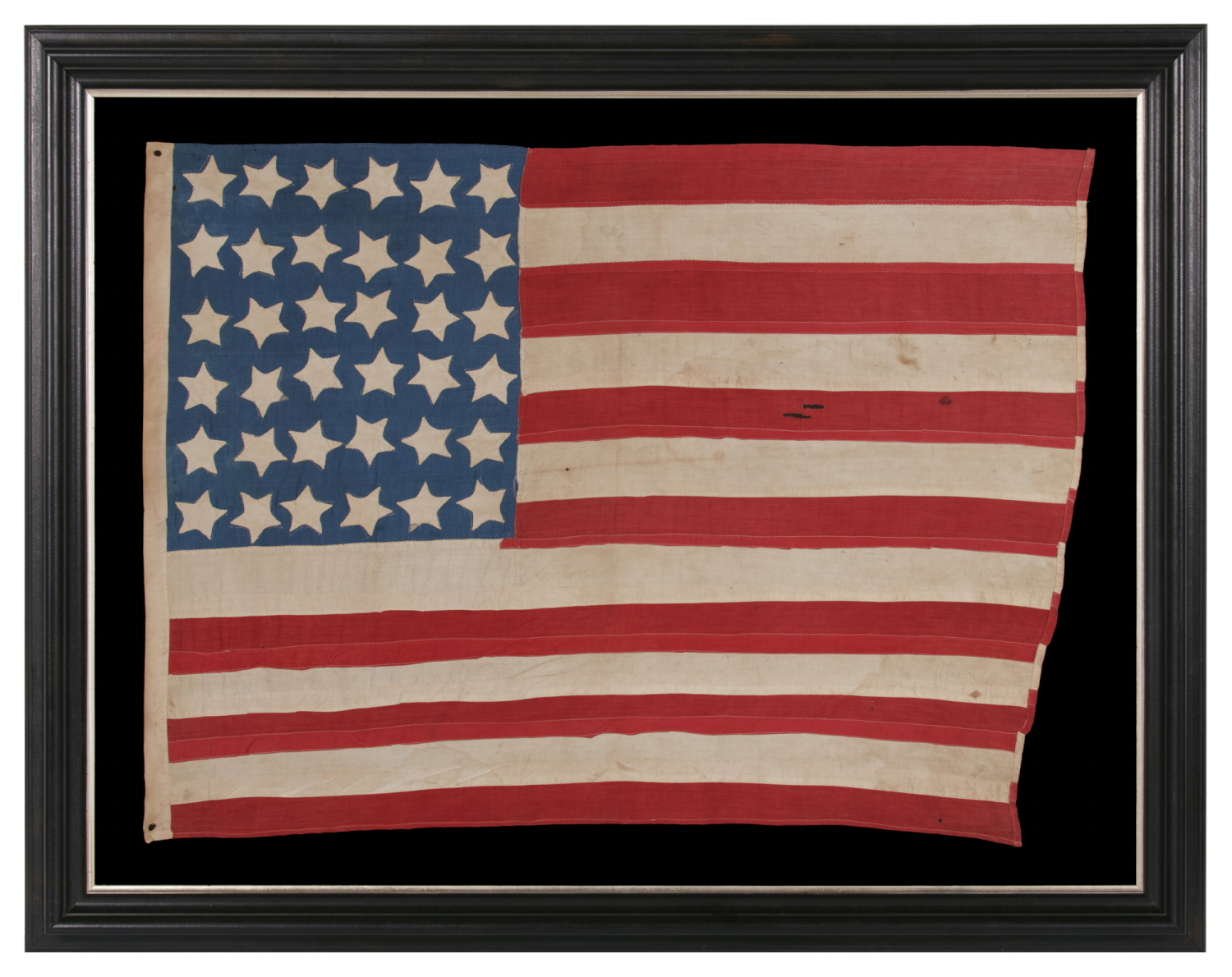


| ANTIQUE AMERICAN FLAG WITH 36 STARS ON A CORNFLOWER BLUE CANTON, CIVIL WAR ERA, 1864-1867, REFLECTS THE ADDITION OF NEVADA AS THE 36TH STATE; A GREAT FOLK EXAMPLE WITH HAPHAZARD ROWS OF STARFISH-LIKE STARS |
|
| Web ID: | 36j-833 |
| Available: | In Stock |
| Frame Size (H x L): | Approx. 50.5" x 65" |
| Flag Size (H x L): | 39" x 53.5" |
| Description: | |
| 36 star American national flag of the Civil War era with outstanding collector traits. Haphazard rows of fat, starfish-shaped stars fill most of the confines of a brilliant, cornflower blue canton. Note the crude piecing of the thirteen, red and white stripes, joined in an ill-planned manner that results in great variation in width, as well as general irregularity. The 4th red stripe actually falls slightly below the canton, and the height of each does not line up with the corresponding stripe on the reverse. This can clearly be seen at the fly end, which is is turned back and bound to repair obvious extended use in an outdoor environment. Clearly the maker lacked experience in seam work. Lining up the necessary components, so that they could be viewed on both sides, presented a challenge they may have not previously faced. This is also evident in the sewing of the stars, which do not line up on the obverse and reverse sides, as they typically would in a flag sewn by an experienced flag-maker. That said, this is just this kind of homemade charm that fuels interest in early American flags among both flag collectors and collectors of American folk art. Even the wavy profile line of the fly end adds whimsical appeal. The stars are hand-sewn, made of cotton, and are double-appliquéd (applied to both sides). The stripes and canton are made of cotton. The latter was joined to the striped field with hand-stitching along the fly end side and with treadle stitching along the lower edge. The stripes were pieced and joined with treadle stitching and there is a cotton binding along the hoist, bound in the same manner, with two hand-sewn, whip-stitched grommets. The color of the canton is especially attractive. Because there were no specified shades of red or blue until 1912, anything was possible. Note how the proportions of the flag are rather close to square, and how the canton is actually taller than it is long. This format is similar to that of regulation, Civil War period, Union infantry battle flags, which were 6 x 6.5 feet. Even the proportions of the canton, being taller than it is long, is shared by many Civil War battle flags. Even though this is certainly not the flag’s original length—it having been properly hemmed so that it could see further use during this patriotic and heroic period—the resulting measurements are both interesting for a flag of this era, and very small among its counterparts. Because most 19th century flags with pieced-and-sewn construction were 8 feet in length or larger, making them difficult to frame and display in an indoor setting, both collectors and one-time buyers alike many times prefer smaller examples, like this one, which is bold enough to make a significant statement, yet manageable in scale. Lincoln pushed Nevada through to statehood on October 31st, 1864, during the Civil War, and just 8 days before the November election. The territory’s wealth in silver was attractive to a nation struggling with the debts of war and so increased support for the Republican ticket. While the 36th star wasn't officially added until July 4th of the following year, some flag-makers would have begun adding the 36th star as early as July of 1864, several months before the addition of the state actually occurred, and almost all would have added it after Nevada was in. This would be especially true among homemade flags like this one. Adding stars before they were official was common practice during the late 19th century and reflects both the nation's desire for Westward Expansion and the hope of flag-makers to bring new star counts to market before their competitors. The 36 star flag was officially replaced by the 37 star flag in 1867, following the addition of Nebraska. Mounting: The flag was mounted and framed within our own conservation department, which is led by expert staff. We take great care in the mounting and preservation of flags and have framed thousands of examples. The background is 100% cotton twill, black in color, that has been washed and treated for color-fastness. The black-painted and hand-gilded molding is Italian. The glazing is U.V. protective plexiglass. Feel free to contact us for more details. Condition: There is minor to modest foxing and staining throughout the white cotton fabric, accompanied by modest spots near the end of the 4th, 5th, and 10th stripes. There is a very small, dark spot near the canton in the 6th stripe. There are 4 tiny holes in the canton, accompanied by two lineal tears, with modest loss, near the center of the 5th stripe, and a tiny hole near the fly end in the last stripe. As previously noted, the fly end was turned back during the flag’s course of use. Many of my clients prefer early flags to show their age and history of use. |
|
| Video: | |
| Collector Level: | Advanced Collectors and the Person with Everything |
| Flag Type: | Sewn flag |
| Star Count: | 36 |
| Earliest Date of Origin: | 1864 |
| Latest Date of Origin: | 1867 |
| State/Affiliation: | Nevada |
| War Association: | 1861-1865 Civil War |
| Price: | Please call (717) 676-0545 or (717) 502-1281 |
| E-mail: | info@jeffbridgman.com |
 |
|